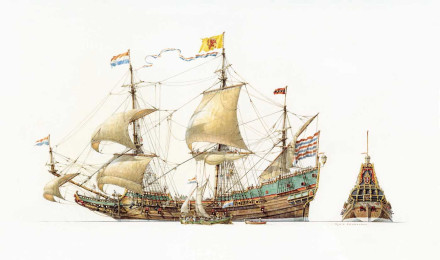History
First settlement at the Cape
Nieuw Haarlem was built in 1636 by the VOC chamber of Amsterdam, and was on her fourth homeward bound voyage to the Netherlands in 1647, alongside the Olifant and the Schiedam. She was sailing from Batavia to Holland and reached the Cape of Good Hope on 25 March, 1647. However, she was caught in a storm and sank in Table Bay. 40 of the crew headed for St Helena aboard an English ship to eventually find a ship journeying home. The remaining 62 survivors used the salvaged cargo to creat a settlement in order to wait for another VOC ship to pass and rescue them. A year later the survivors and remaining cargo were pick up by a passing ship.
During the forced stay of the survivors,the idea was born of founding a permanent victualing station for the purposes of supplying passing VOC ships with fresh water and fruit, as well as provide a haven for survivors of future shipwrecks. When they had returned to the Netherlands, junior officer Jansz and another VOC employeee Proot, presented a report to the directors of the VOC on the advantages of using the Cape as a victualling station. This was positively received.
To achieve this plan, the VOC sent an expedition of five VOC ships in 1652 led by Jan van Riebeeck to establish a permanent victualing station. This was the only settlement ever founded by the Dutch East India Company that had no trading purpose, and merely served as a safe haven for VOC ships that needed to moor for repairs, heal the sick, and take in fresh fruits and vegetables to keep their crews strong and healthy.
The wreck of Haarlem began the occupation of the Cape region by the Dutch. Riebeek's men built a small wooden fort in 1653, the Redout Duijnhoop, which was later replaced by the Castle of Good Hope, as well as a hospital. In addition, crops and fruits were planted to supply the passing ships. To work the fields a number of VOC employees were relieved of duty and assigned a small piece of land. Employees that had a craft, from which the VOC could benefit, such as carpenters and blacksmiths, were also given permission to settle at the Cape.



Description
| People on board | 120 |
|---|---|
| Tonnage | 500 ton (250 last) |
Status
The survivors reportedly managed to salvage the camphor, cinnamon, pepper, indigo, textile, sugar and some of the porcelain from the wreck before it became inaccessible. They also brought several of the iron cannons to shore for protection.
The Haarlem has been the subject of much academic research, particularly the location of the wreck and the survivor camp. Attempts to locate these on the nearby shore have, to date, been unsuccessful but are ongoing.
Six cannons were also taken aboard when the survivors were rescued, thus leaving 19 cannons and four large anchors in the wreck. It is unclear, though, whether cannons were left behind in the camp.
References
- Bruno Werz.
The search for 'Haarlem'. - andere tijden Op zoek naar VOC schip Haarlem.
- NA 1.11.06.18.
- Lesa la Grange, Martijn Manders, Briege Williams, John Gribble and Leon Derksen (2024).
Dutch Shipwrecks in South African Waters: A Brief History of Sites, Stores and Archives [Unpublished].